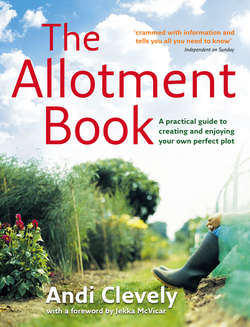Читать книгу The Allotment Book - Andi Clevely - Страница 35
structures & equipment
ОглавлениеThe shed The allotment shed stands at the heart of the plot-holder’s domain, a private sanctuary that has often inspired creativity and latent building skills (see pages 42–3). Whether flatpack or makeshift in style, it is a key structure that dominates the plot and provides refuge from bad weather, a store for tools and materials, and very often a simple retreat in which to relax, brew tea and potter.
On some allotment sites, inspired DIY and frugal recycling of old doors, pallets, plastic sheeting, household paint and roofing felt is permissible. The result is an enchanted huddle of shacks and shanties that tap into childhood memories of dens and seem to be in a constant state of renovation or repair. Elsewhere, strict regulations insist that all plot-holders use the standard issue of a basic weatherboarded and unpainted tool store.
Whatever its design, your shed is an essential part of the allotment’s working environment, and so needs some thought if it is to be weatherproof, secure and well equipped for your various activities on site.
IDEAL SPECIFICATION If you are considering buying or building your own shed, you should take into account the following important features.
Size Many allotment associations set a maximum base size of 2.1 x 1.5m (7 x 5ft). A smaller area might seem sufficient, but you should decide first if you need room for working or for sitting and resting as well as for storing your tools and tackle. Make sure that there is enough headroom to stand comfortably, allowing for any structural cross-braces in the roof.
Floor The floor should be sound, firm and durable. Pressure-treated boards are standard, laid on treated bearers that sit on a bed of gravel for good drainage. A permanent concrete foundation may not be allowed, but concrete blocks will keep the floor bearers off the ground.
Roof The roof must be strong, ideally made of tongue-and-groove boards rather than plywood, and waterproofed with felt that covers overhanging eaves. A flat roof must have sufficient fall to shed rainwater. A covering of turf or plants would provide a ‘green’ solution. Add guttering to collect rainwater (into water butts) and protect the shed walls.
Door The door should be wide enough for comfortable access by you and your largest equipment, such as a wheelbarrow, and soundly constructed with strong ledges and braces. Furniture such as hinges and latches should be rust-resistant – galvanized or stainless steel, for example – and you must have a strong lock (see also page 43).
